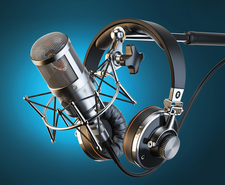Mastering and mixing with Ardour
Sound Explorer

Once you get your podcast operation up and running, you might decide you want a real mixer and some higher-end software. We'll introduce you to Ardour and get you started with some basic audio hardware.
Podcasting often occupies a space on the low end of the audio recording spectrum. All you really need is a computer, suitable software, and a microphone. Some users, however, might wish to avoid this most basic scenario. You might ask, "If I'm going to all the trouble to set up a studio for podcasting, what else can I do with it?" Or you might want your studio to grow into something more sophisticated. Perhaps you are a musician yourself? Or you wish to host live music – or other performance alternatives that require mixing and multiple mics.
In these scenarios, you could easily outgrow the simple mic+Audacity configuration. If you're looking for something more, try Ardour.
Ardour [1] is still considered the reference application as a free tool for recording and mixing on Linux. A variety of alternatives also exist – for instance, Muse is a good option if you are composing music with MIDI, and Qtractor offers some innovative features for working loops and samples – but when it comes to mixing and mastering, Ardour is unsurpassed.
[...]
Buy this article as PDF
(incl. VAT)
Buy Linux Magazine
Subscribe to our Linux Newsletters
Find Linux and Open Source Jobs
Subscribe to our ADMIN Newsletters
Support Our Work
Linux Magazine content is made possible with support from readers like you. Please consider contributing when you’ve found an article to be beneficial.

News
-
Mozilla Plans to AI-ify Firefox
With a new CEO in control, Mozilla is doubling down on a strategy of trust, all the while leaning into AI.
-
Gnome Says No to AI-Generated Extensions
If you're a developer wanting to create a new Gnome extension, you'd best set aside that AI code generator, because the extension team will have none of that.
-
Parrot OS Switches to KDE Plasma Desktop
Yet another distro is making the move to the KDE Plasma desktop.
-
TUXEDO Announces Gemini 17
TUXEDO Computers has released the fourth generation of its Gemini laptop with plenty of updates.
-
Two New Distros Adopt Enlightenment
MX Moksha and AV Linux 25 join ranks with Bodhi Linux and embrace the Enlightenment desktop.
-
Solus Linux 4.8 Removes Python 2
Solus Linux 4.8 has been released with the latest Linux kernel, updated desktops, and a key removal.
-
Zorin OS 18 Hits over a Million Downloads
If you doubt Linux isn't gaining popularity, you only have to look at Zorin OS's download numbers.
-
TUXEDO Computers Scraps Snapdragon X1E-Based Laptop
Due to issues with a Snapdragon CPU, TUXEDO Computers has cancelled its plans to release a laptop based on this elite hardware.
-
Debian Unleashes Debian Libre Live
Debian Libre Live keeps your machine free of proprietary software.
-
Valve Announces Pending Release of Steam Machine
Shout it to the heavens: Steam Machine, powered by Linux, is set to arrive in 2026.

